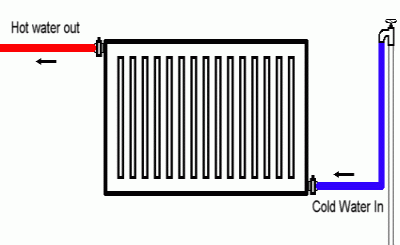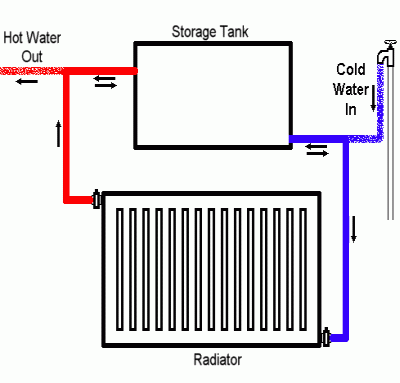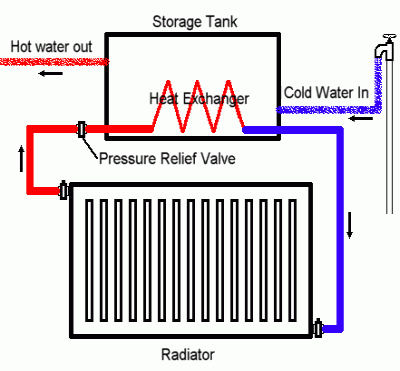Right then I picked up a small radiator from freecycle yesterday. It was great fun getting back on busses during rush hour.
I intend to set it up somewhere in the back yard, perhaps on the tyres that I have from growing my potaotes. I still have all the earth that was in them to weigh them down and I imagine I will need something to insulate between the tyres and the radiator contraption so that the tyres don't melt.
I have some glass on my allotment to help insulate it and there is a 'stand pipe' tap in my back yard to run water through it.
I intend to paint it black and make a little insulated box for it to fit inside then run a pipe comming from it to get hot water.
The bloke I picked it up from said that he managed to get boiling hot water in an hour and a half when he tried the same. So what pipes do I need? copper pipes, bit expensive if I can't get them on freecycle.
Also if can I get away with running a garden hose from the stand pipe to the radiator? obviously it would have to have some sort of connection to isolate it from the heat that the radiator will generate.
Will I have to clean out then radiator before I use it? I might just use it for washing up water although it would be great to be able to have a device to get hot water for tea and for cooking would save a fortune in electricity as well as gas if I could do that.
I need this device to be a simple as possilble and with the least amount of parts for it to work as I am not that practicle when it comes to heath robinson devices.
Any advice will be most greatfully recieved.
I have a radiator what now?
- Andy Hamilton
- Site Admin

- Posts: 6631
- Joined: Tue Oct 26, 2004 11:06 pm
- Location: Bristol
- Contact:
I have a radiator what now?
First we sow the seeds, nature grows the seeds then we eat the seeds. Neil Pye
My best selling Homebrew book Booze for Free
and...... Twitter
The Other Andy Hamilton - Drinks & Foraging
My best selling Homebrew book Booze for Free
and...... Twitter
The Other Andy Hamilton - Drinks & Foraging
-
Martin
- A selfsufficientish Regular

- Posts: 2029
- Joined: Sat May 06, 2006 8:50 am
- Location: Nr Heathfield, East Sussex
- Contact:
Ideally you'd put it in a glass-fronted box with insulation behind it - it increases efficiency enormously - painting it MATT black helps too! You could possibly get away with some form of armoured hosing, but I wouldn't rely on hosepipe to carry heated water - ideally cadge some proper copper pipe and fittings, it's a lot safer! 
Then angle your panel at about 45degrees towards the south, and put it as low as possible - have a small reservoir say 3-4 ft above it, and run the pipes between the two (it should then thermosyphon). Insulate the reservoir as best you can, and it should work quite well. The problem with all flat plates is that they are as good at radiating heat as collecting it, so it's a good idea to either disconnect it at night, or cover the radiator with something like foil and bubble wrap at to save losing what heat you have in the reservoir
Then angle your panel at about 45degrees towards the south, and put it as low as possible - have a small reservoir say 3-4 ft above it, and run the pipes between the two (it should then thermosyphon). Insulate the reservoir as best you can, and it should work quite well. The problem with all flat plates is that they are as good at radiating heat as collecting it, so it's a good idea to either disconnect it at night, or cover the radiator with something like foil and bubble wrap at to save losing what heat you have in the reservoir
http://solarwind.org.uk - a small company in Sussex sourcing, supplying, and fitting alternative energy products.
Amateurs encouraged - very keen prices and friendly helpful service!
Amateurs encouraged - very keen prices and friendly helpful service!
- Muddypause
- A selfsufficientish Regular

- Posts: 1905
- Joined: Mon Apr 11, 2005 4:45 pm
- Location: Urban Berkshire, UK (one day I'll find the escape route)
I reckon you've got three options, and I just happened to have spent the afternoon tinkering with a graphics editor. So:
1) The simplest; low capacity, simple plumbing (use hoepipes and jubilee clips if you like). Nothing is under much pressure.

2) Slightly more capacity

3) More complicated

1) & 2) will mean that the water you use will have been circulating through the radiator. As central heating systems use lots of chemicals, you will need to flush the rad. out extremely well before you can use the water near any food of drink. There may also be longer term issues with corrosion and furring up. In 3) the water circulating through the rad. is in a separate circuit, so you won't come into contact with it, corrosion should be minimal, as will furring. You can put antifreeze in, too, as a winter precaution.
The heat exchanger in 3) could be a coil of pipe, or maybe a small car radiator, or something. The pressure relief valve is just a simple spring loaded valve that does what it says if the hot water expands more that the system can cope with. In a small system like this, you may get away without it, especially if you are using flexible pipe like hosepipe to connect it all together.
For 2) & 3), it may benefit from a small pump to circulate the water (maybe a pond or fishtank pump). Also, as Marin says, once the sun goes in, these will re-emit all the heat they have absorbed, so 1) may not be up for much in the mornings. You have the option of putting the storage tank in 2) & 3) inside, remote from the rad. Turn off the pump, or close the radiator valves at night and it should keep some heat in a bit better.
It really would help to have one of the rad. valves at the bottom and one at the top, as per the illustrations, but this may require a bit of brute force and swearing with a spanner or big alan key.
In all cases, you get hot water by turning on the cold tap that it is connected to. It is, probably, technically against water by-laws to leave it connected to the tap, so a valve of some sort to close on that pipe before you disconnect would be a good idea.
Edit:
Re. number 2); I guess you'll also need to add a little upward kink in the pipe to stop the water cycling through the radiator and out of the open outlet:

1) The simplest; low capacity, simple plumbing (use hoepipes and jubilee clips if you like). Nothing is under much pressure.

2) Slightly more capacity

3) More complicated

1) & 2) will mean that the water you use will have been circulating through the radiator. As central heating systems use lots of chemicals, you will need to flush the rad. out extremely well before you can use the water near any food of drink. There may also be longer term issues with corrosion and furring up. In 3) the water circulating through the rad. is in a separate circuit, so you won't come into contact with it, corrosion should be minimal, as will furring. You can put antifreeze in, too, as a winter precaution.
The heat exchanger in 3) could be a coil of pipe, or maybe a small car radiator, or something. The pressure relief valve is just a simple spring loaded valve that does what it says if the hot water expands more that the system can cope with. In a small system like this, you may get away without it, especially if you are using flexible pipe like hosepipe to connect it all together.
For 2) & 3), it may benefit from a small pump to circulate the water (maybe a pond or fishtank pump). Also, as Marin says, once the sun goes in, these will re-emit all the heat they have absorbed, so 1) may not be up for much in the mornings. You have the option of putting the storage tank in 2) & 3) inside, remote from the rad. Turn off the pump, or close the radiator valves at night and it should keep some heat in a bit better.
It really would help to have one of the rad. valves at the bottom and one at the top, as per the illustrations, but this may require a bit of brute force and swearing with a spanner or big alan key.
In all cases, you get hot water by turning on the cold tap that it is connected to. It is, probably, technically against water by-laws to leave it connected to the tap, so a valve of some sort to close on that pipe before you disconnect would be a good idea.
Edit:
Re. number 2); I guess you'll also need to add a little upward kink in the pipe to stop the water cycling through the radiator and out of the open outlet:

Stew
Ignorance is essential
Ignorance is essential
- Andy Hamilton
- Site Admin

- Posts: 6631
- Joined: Tue Oct 26, 2004 11:06 pm
- Location: Bristol
- Contact:
I am glad that you were tinkering Muddy, nice one. I am thinking that I will have a bash at 1 first and see how that works before jumping to 2 or 3.
I think between you and Martin you have given me a viable option to have a go at.
 cheers lads.
cheers lads.
I think between you and Martin you have given me a viable option to have a go at.
First we sow the seeds, nature grows the seeds then we eat the seeds. Neil Pye
My best selling Homebrew book Booze for Free
and...... Twitter
The Other Andy Hamilton - Drinks & Foraging
My best selling Homebrew book Booze for Free
and...... Twitter
The Other Andy Hamilton - Drinks & Foraging
-
Martin
- A selfsufficientish Regular

- Posts: 2029
- Joined: Sat May 06, 2006 8:50 am
- Location: Nr Heathfield, East Sussex
- Contact:
if you're going for true simplicity, and want to trickle it through the radiator, there's an even easier way - forget the radiator all together, get a long length of black hose, and thread it up the middle of loads of empty clear plastic pop bottles - just make a hole in the base of each (a cross cut would probably do) - lay out on the ground, and allow the water to trickle through it! 
http://solarwind.org.uk - a small company in Sussex sourcing, supplying, and fitting alternative energy products.
Amateurs encouraged - very keen prices and friendly helpful service!
Amateurs encouraged - very keen prices and friendly helpful service!